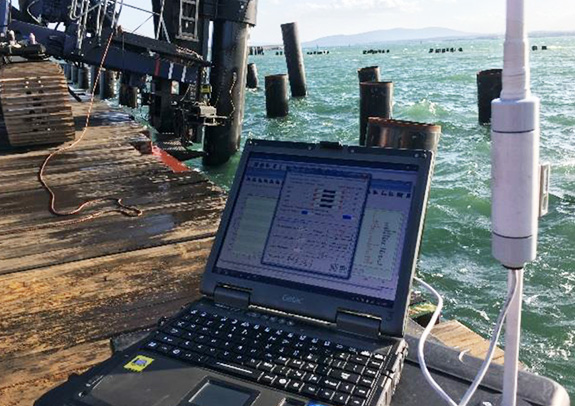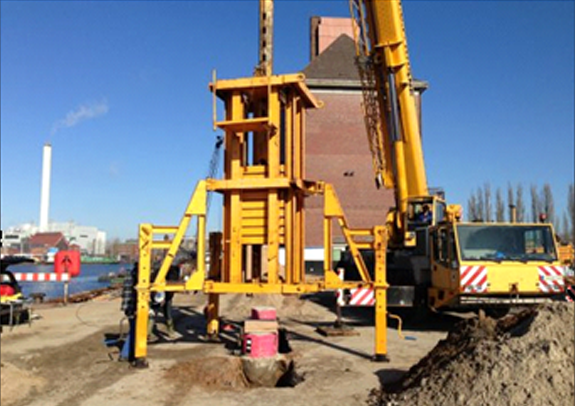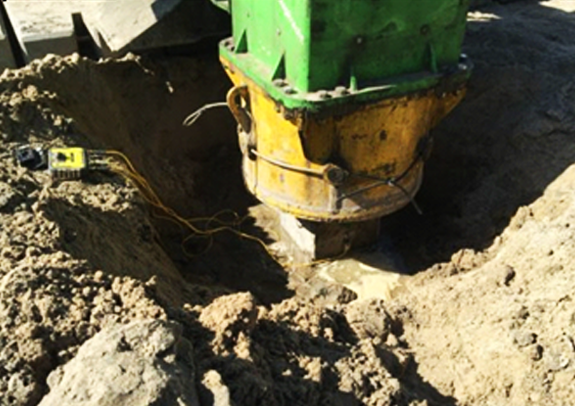
Dynamic Pile Load Test
Dynamic Pile Load Test (DLT) / Pile Driving Analyzer helps to evaluate the pile load capacity based on the force which is applied by the hammer. The methodology and instrument specification for DLT is defined in ASTM D4945 & IRC Standard recommends the dynamic pile load testing.
The pair of accelerometer and strain transducers are attached on pile diagonally at 1.5 times the diameter below the pile head. The Impact force causes the generation of the stress wave in the pile. The stress wave propagates in pile and gets reflected from the toe or where discontinuity confronted. The signal matching software is used along with the soil parameter to estimate the pile load capacity corresponding to the impact force which applied to the pile.
The total process of pile installation during driving can be monitored with the Allnamics PDA set. PDA stand for pile driving analysis or pile driving monitoring. Parameters of hammer, pile and soil can be monitored to optimize the pile driving process and hammer efficiency, the condition of the pile cushioning, to avoid problems i.e. by limit the pile stresses in both compression and tension, to monitor the behaviour of the soil, entrance in or passing of soil layers and to control the performance related to drivability studies and soil investigations.
The same monitoring set-up can be used for Dynamic Load Testing (or High Strain Dynamic Testing), when the precast pile is redriven after a set - up period, or when an impact is given on
cast-in-situ piles. Elaboration of the signals by the Signal Matching technique of All Wave-DLT lead to prediction of the static load-settlement behaviour (DLT).
Pile Driving Analysis (or PDA) reduces the risk of damage to both the pile and the hammer and allows the contractor to drive the pile efficiently to the optimum or required depth.

Features
- THD 102 dB.
- Weight:1.8 kg.
- Class IP66 housing.
- Basic unit accuracy < 0.3%FS.
- Resolution 24 bit A/D conversion.
- PDR, high speed data acquisition system.
- Operates in metric SI or Imperial/US units.
- In compliance with EMC, ESD, ASTM D4945.
- Automatic balancing and signal conditioning.
- Dimensions: 220 x 200 x 100 mm (9 x 8 x 4 in).
- Adjustable sample rate up to 48kHz per channel.
- Easy upgrade to 8 universal channel monitoring.
- 6 hrs operational battery life (up to 30 days standby).
- Free selection of trigger channel (1 to 4) or external trigger.
- Free selectable pre-trigger period/buffer size and trigger delay.
- Fully compatible with intelligent combined transducers (USID).
- Software program for monitoring, processing and reporting included.
- Robust design with easy magnetic stowaway system for excess cable.
- Support multiple languages (English, German, Spanish, other on request).
- High speed internet LAN - 100, IEEE 802.3, 100 Mb/s, and WiFi IEEE802.11.
- Integrated test box (to automatically check the transducers during mounting.
- 4 universal channels (for strain, acceleration, velocity, force, displacement, and more).
- Internal Solid State recorder with 4 Gb memory for signal backup and standalone recording.
- Wireless Wi-Fi connection to a Windows PC laptop. Alternative data communication through ethernet or analogue cable.

Test Data

Setup of Hammer on pile head

Fixed Sensor on pile head